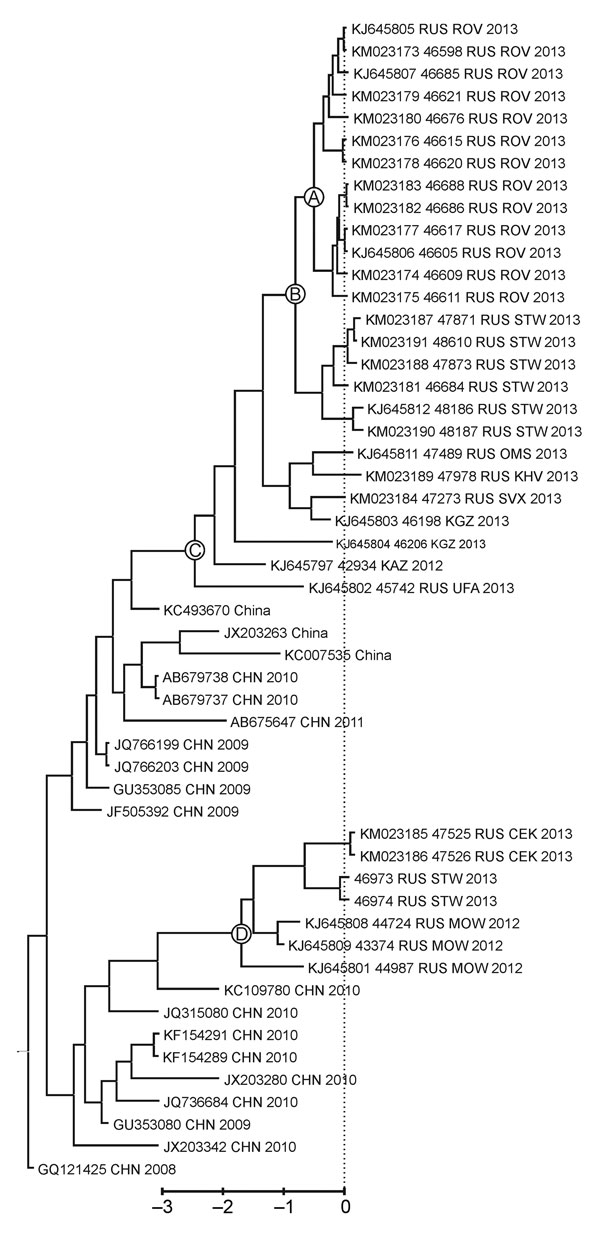Volume 21, Number 8—August 2015
Dispatch
Enterovirus A71 Meningoencephalitis Outbreak, Rostov-on-Don, Russia, 2013
Figure 2

Figure 2. Phylogenetic tree comparing sequences of outbreak and other enterovirus A type 71 (EV-A71) subgenogroup C4 strains isolated in Russia during 2012–2013 with the most closely related sequences in GenBank. Complete viral protein 1 genome regions (891 nt) were compared. The tree was reconstructed by using a coalescent Bayesian algorithm implemented in BEAST 1.7.5 (11) with the SRD06 substitution model, relaxed exponential clock, and constant population prior. The dataset included 63 GenBank sequences that were most similar to the outbreak virus, as determined by using BLAST (http://www.ncbi.nlm.nih.gov/blast/Blast.cgi), and 22 EV-A71 subgenogroup C4 sequences obtained elsewhere in Russia, Kazakhstan, and Kyrgyzstan during 2011–2013 (10). Only the part of the tree that is relevant to the discussion is shown. Strain names contain the GenBank or internal reference number, country of isolation, city code for Russian isolates, and year of isolation. City codes: CEK, Chelyabinsk; CHN, China; KAZ, Kazakhstan; KGZ, Kyrgyzstan; KHV, Khabarovsk; MOW, Moscow; OMS, Omsk; ROV, Rostov; RUS, Russia; STW, Stavropol; SVX, Yekaterinburg; UFA, Ufa. GenBank accession numbers for previously unpublished viruses (KM023173–KM023191) are shown in the tree. The dotted line shows the outbreak onset on May 31 (some strains were isolated after that date). Circled letters indicate sequences for viruses isolated in Rostov-on-Don and the Rostov Region of Russia (A); Stavropol region of Russia, which neighbors Rostov Region (B); Siberia, the Pacific region of Russia, Kazakhstan, and Kyrgyzstan (C); and Stavropol, central Russia and Ural Region (D). Scale bar indicates year before the 2013 outbreak.
References
- McMinn PC. Recent advances in the molecular epidemiology and control of human enterovirus 71 infection. Curr Opin Virol. 2012;2:199–205. DOIPubMedGoogle Scholar
- Schuffenecker I, Mirand A, Antona D, Henquell C, Chomel JJ, Archimbaud C, Epidemiology of human enterovirus 71 infections in France, 2000–2009. J Clin Virol. 2011;50:50–6. DOIPubMedGoogle Scholar
- Bible JM, Iturriza-Gomara M, Megson B, Brown D, Pantelidis P, Earl P, Molecular epidemiology of human enterovirus 71 in the United Kingdom from 1998 to 2006. J Clin Microbiol. 2008;46:3192–200. DOIPubMedGoogle Scholar
- Witsø E, Palacios G, Ronningen KS, Cinek O, Janowitz D, Rewers M, Asymptomatic circulation of HEV71 in Norway. Virus Res. 2007;123:19–29. DOIPubMedGoogle Scholar
- Vallet S, Legrand Quillien MC, Dailland T, Podeur G, Gouriou S, Schuffenecker I, Fatal case of enterovirus 71 infection, France, 2007. Emerg Infect Dis. 2009;15:1837–40. DOIPubMedGoogle Scholar
- Chumakov M, Voroshilova M, Shindarov L, Lavrova I, Gracheva L, Koroleva G, Enterovirus 71 isolated from cases of epidemic poliomyelitis-like disease in Bulgaria. Arch Virol. 1979;60:329–40. DOIPubMedGoogle Scholar
- Nagy G, Takatsy S, Kukan E, Mihaly I, Domok I. Virological diagnosis of enterovirus type 71 infections: experiences gained during an epidemic of acute CNS diseases in Hungary in 1978. Arch Virol. 1982;71:217–27. DOIPubMedGoogle Scholar
- Simovanian EN, Denisenko VB, Bovtalo LF, Belugina LV, Kim MA, Kukhol YS. Enterovirus infection–71 in children: clinics, diagnostics and management [in Russian]. In: Abstracts of the VI annual All-Russian Congress on Infectious Diseases; Moscow; 2014 Mar 24–26. Moscow: the Congress; 2014. p. 286–7.
- Ho M, Chen ER, Hsu KH, Twu SJ, Chen KT, Tsai SF, An epidemic of enterovirus 71 infection in Taiwan. Taiwan Enterovirus Epidemic Working Group. N Engl J Med. 1999;341:929–35. DOIPubMedGoogle Scholar
- Akhmadishina LV, Eremeeva TP, Trotsenko OE, Ivanova OE, Mikhailov MI, Lukashev AN. Seroepidemiology and molecular epidemiology of enterovirus 71 in Russia. PLoS ONE. 2014;9:e97404. DOIPubMedGoogle Scholar
- Drummond AJ, Rambaut A. BEAST: Bayesian evolutionary analysis by sampling trees. BMC Evol Biol. 2007;7:214. DOIPubMedGoogle Scholar
- McWilliam Leitch EC, Cabrerizo M, Cardosa J, Harvala H, Ivanova OE, Koike S, The association of recombination events in the founding and emergence of subgenogroup evolutionary lineages of human enterovirus 71. J Virol. 2012;86:2676–85. DOIPubMedGoogle Scholar
- Lukashev AN, Shumilina EY, Belalov IS, Ivanova OE, Eremeeva TP, Reznik VI, Recombination strategies and evolutionary dynamics of the human enterovirus A global gene pool. J Gen Virol. 2014;95:868–73. DOIPubMedGoogle Scholar